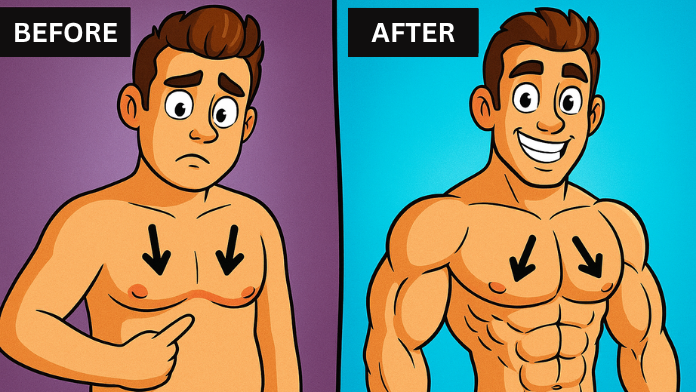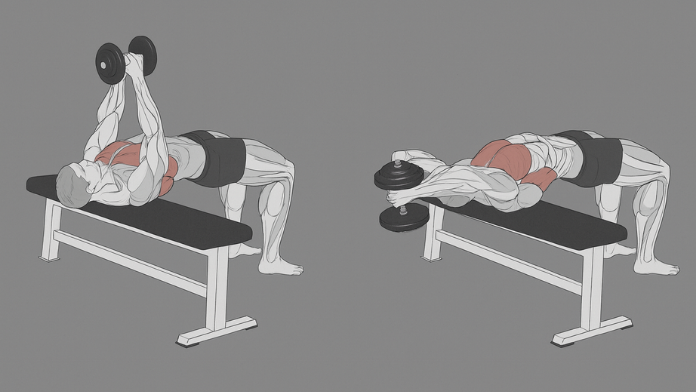
A well-developed chest is one of the most sought-after goals in fitness, yet many lifters struggle to build the lower portion effectively. You may train your chest regularly, but if the lower region still appears flat, undefined, or out of proportion, the issue is rarely effort—it’s technique and exercise selection. This is exactly where a targeted Lower Chest Workout becomes essential. The lower chest requires precise angles, controlled movement, and focused activation to respond and grow.
This guide breaks down how to train the lower chest with science-backed exercises, proper form cues, practical tips, and a structure that eliminates guesswork. You’ll learn the best lower chest workouts, discover the most effective decline and parallel motion patterns, understand beginner-to-advanced progressions, and get a complete routine that helps you carve a sharper chest line.
This lower chest exercise guide provides the clarity, strategy, and precise movements you require, whether your goal is greater definition, a cleaner chest taper, or balanced aesthetics.
Understanding the Lower Chest: Why It’s Hard to Grow
Training the lower chest isn’t simply about pushing heavier weights. The lower region is influenced by angle, shoulder position, and the direction of resistance. Many lifters unknowingly emphasize the mid or upper chest even when they believe they’re training the lower fibers.
The lower chest (the sternal head of the pectoralis major) activates best when the arms move downward or diagonally down from the chest line. This requires intentional movement patterns rather than traditional horizontal pressing alone.
Common challenges include:
• Using flat bench exercises too often
• Allowing shoulders to dominate pressing movements
• Poor mind-muscle connection
• Incorrect bench angles
• Rushing reps instead of controlling tension
Once you understand these mechanics, the path to better lower chest development becomes clear.
Benefits of Lower Chest Workout Training

A well-rounded lower chest workout delivers more than aesthetics. You’ll notice improvements in strength, stability, posture, and functional movement. Here’s what you gain by integrating targeted lower chest workouts:
• Improved Chest Definition: The lower chest adds the sharp “under-line” that makes the chest look fuller.
• Balanced Upper–Lower Symmetry: Avoids a top-heavy chest appearance.
• Better Push Strength: Decline pressing patterns transfer to everyday pushing tasks.
• Stronger Mind–Muscle Connection: Helps you isolate and engage chest fibers more efficiently.
• Enhanced Shoulder Relief: Proper lower chest training reduces unnecessary shoulder strain.
These benefits support both beginners rebuilding fundamentals and advanced lifters refining aesthetics.
How to Activate the Lower Chest Workout Properly
Before jumping into lower chest best workouts, activation sets help prime the muscle so it engages during heavier lifts. Think of this as “waking up” the fibers.
Step-by-step Activation Guide
1. Start with light weights
Use 2–4 kg dumbbells or resistance cables.
2. Perform Downward Fly Movements
Keep elbows slightly bent and sweep arms down and inward.
Aim for 12–15 slow reps.
3. Engage the Chest, Not the Shoulders
Pull the weight using the inner chest, not the deltoids.
4. Maintain a Small Chest Lift
Elevate your chest slightly to create a natural contraction arc.
5. Visualize the Movement
Imagine squeezing the lower chest line together on every rep.
Proper activation enhances the effectiveness of your lower chest workout session and dramatically improves muscle recruitment.
The 10 Best Chest Workouts for Lower Chest Growth (With Form Cues)
Below are the most effective lower chest exercises divided by equipment type. These ensure well-rounded training whether you work out at home or the gym.
1. Decline Barbell Bench Press (Primary Lower Chest Mass Builder)
If you want heavy strength development, decline pressing is unrivaled. The angle naturally targets the lower chest while minimizing shoulder involvement.
How to Perform It
• Set the bench at a 15–30° decline.
• Grip the bar slightly wider than shoulder-width.
• Lower the bar to the lower chest line (not mid-chest).
• Press upward following the same diagonal path.
Pro Tips
• Keep elbows at a 45° angle.
• Do not flare the elbows outward.
• Control the descent for better tension.
Decline bench remains one of the best chest workouts for lower chest size and strength.
2. Decline Dumbbell Press (Improves Stability & Fiber Recruitment)
Dumbbells force each side of the chest to work individually, preventing dominance from the stronger side.
How to Do It
• Lie on a decline bench with dumbbells above your chest.
• Lower slowly with a natural arc.
• Press upward, squeezing the lower pecs.
Why It Works
Dumbbells allow deeper stretch and better contraction.
3. Cable Lower Chest Fly (Precise Isolation)
This is one of the most controlled and effective lower chest workouts.
Form Cues
• Set cable pulleys slightly above shoulder height.
• Step forward into a staggered stance.
• Sweep arms downward in an arc toward your navel.
Best Tip
Pause for a second at the bottom to feel the inner-lower chest squeeze.
4. Decline Push-Ups (Zero Equipment Option)
Perfect for home workouts, decline push-ups mimic the angle of decline pressing.
How to Do It
• Place feet on a bench or step.
• Lower your chest toward the floor.
• Push explosively upward.
Key Benefit
This movement loads the lower chest more than flat push-ups.
5. Dip Machine or Weighted Dips (Advanced Lower Chest Heavy Lifter)
Dips emphasize the lower chest when executed with a forward lean.
Technique Steps
• Lean your torso forward at a slight angle.
• Lower slowly until elbows reach 90 degrees.
• Push up while maintaining the forward lean.
Caution
Avoid dipping too deep to prevent shoulder strain.
6. Chest Dip (Bodyweight Version)
If you don’t have access to a machine, parallel bars work well.
Form Tips
• Cross legs behind you.
• Lean forward.
• Drive up with chest, not triceps.
This is one of the most underrated lower chest workouts for building the under-pec shape.
7. Low Cable Press (Downward Diagonal Pressing)
Think of this exercise as a decline bench but with cables and more range control.
How to Perform
• Set the pulleys slightly below the chest.
• Push diagonally down and forward.
• Keep wrists neutral.
The constant cable tension maximizes muscle fiber engagement.
8. Decline Chest Press Machine (Beginner-Friendly Mass Builder)
Ideal for those needing stability while learning movement patterns.
Why It’s Effective
• Predictable resistance path
• Safety without spotter
• Smooth contraction arc
Perfect for beginners and intermediate lifters.
9. Dumbbell Pullover (Lower Fiber Stretch & Serratus Activation)
Although primarily a mid-chest exercise, adjusting the angle shifts tension downward.
Modification
• Keep hips slightly lowered.
• Pull dumbbell toward the lower chest line.
This enhances the lower chest stretch and improves definition.
10. Landmine Decline Press (Athlete-Style Movement)
Creates a unique downward pressing angle ideal for the lower chest.
Technique
• Kneel or stand leaning into the bar.
• Press diagonally downward.
• Squeeze chest at full extension.
Great for those who need joint-friendly training.
Complete Lower Chest Workout Routine (Beginner to Advanced)
Below are three structured routines depending on your level.
Beginner Routine (30–40 Minutes)
• Decline Push-ups – 3×12
• Cable Lower Chest Fly – 3×10–12
• Decline Chest Press Machine – 3×10
• Dumbbell Pullover – 2×12
Why It Works
Emphasizes isolation and controlled patterns before progressing to heavier lifts.
Intermediate Routine (45–55 Minutes)
• Decline Dumbbell Press – 4×8–10
• Weighted Dips – 3×8–10
• Low Cable Press – 3×12
• Cable Lower Chest Fly – 3×10
• Decline Push-ups (Burnout) – 1×AMRAP
Goal
Mass + definition + endurance.
Advanced Routine (60–70 Minutes)
• Decline Barbell Bench Press – 5×6–8
• Weighted Dips (Heavy) – 4×6–8
• Low Cable Press – 4×10
• Decline Dumbbell Press – 3×10
• Cable Fly (Downward Arc) – 3×12
• Finisher: Landmine Decline Press – 2×15
Why It Works
Combines power-heavy presses with precise isolation for maximum lower chest growth.
Common Mistakes in Lower Chest Workouts (and How to Fix Them)
Even with the best exercises, poor form can minimize gains. Here are the most common mistakes:
Mistake 1: Using Flat Bench as the Primary Exercise
Flat pressing heavily targets the mid-chest, not the lower region.
Fix
Replace 1–2 flat pressing movements with decline variations.
Mistake 2: Flaring Elbows Outward
Creates shoulder overload and reduces chest activation.
Fix
Maintain a 45° elbow tuck position.
Mistake 3: Rushing the Reps
Lower chest fibers respond best to slow, controlled motions.
Fix
Use a 2-second descent and 1-second squeeze.
Mistake 4: Poor Angle Selection
Too steep or too shallow declines ruin targeting.
Fix
Stay within 15–30° decline angles.
Mistake 5: Forgetting the Squeeze
To build definition, contraction matters more than load.
Fix
Hold the peak contraction for 0.5–1 second on each rep.
Practical Tips to Maximize Lower Chest Activation
1. Warm up dynamically
Shoulder mobility drills prevent injury and improve stability.
2. Use moderate weights for isolation exercises
Heavier loads often shift tension away from the lower chest.
3. Increase volume slowly
Overtraining leads to fatigue, not improvement.
4. Mix angles each week
Use both decline and downward-pressing cable motions.
5. Maintain consistent form
Quality reps produce more growth than excess weight.
Lower Chest Workout Example Weekly Schedule
Day 1 – Strength Focus
• Decline Barbell Press
• Weighted Dips
• Low Cable Press
Day 4 – Isolation Focus
• Cable Lower Chest Fly
• Decline Dumbbell Press
• Landmine Decline Press
Day 6 – Hybrid Pump Day
• Decline Push-ups
• Cable Fly
• Dumbbell Pullover
This schedule delivers volume, intensity, and recovery for optimal progress.
Safety Considerations and Injury Prevention
Lower chest pressing angles load the shoulders and elbows, so technique is crucial. Always:
• Warm up your rotator cuffs
• Avoid locking elbows
• Keep wrists neutral
• Maintain stable scapula positioning
If you experience sharp pain—not normal muscle fatigue—stop and reassess your form.
Conclusion
To build a powerful, well-defined lower chest, you need to choose the right exercises, use the right angles, and stay focused. You can change the shape and symmetry of your lower chest a lot by doing focused decline presses, controlled cable isolation training, and planned routines. This Lower Chest Workout guide equips you with everything you need—from expert cues to complete programs—to train smart, reduce shoulder stress, and sculpt a powerful chest contour. Follow the steps, refine your technique, and stay consistent. Visible results follow disciplined, precision-based training.
FAQs
- What is the best lower chest workout for beginners?
Decline push-ups and cable lower chest flies are great for learning form without heavy load. - How often should I train the lower chest?
Two focused sessions per week are effective for most people. - Does the lower chest respond better to decline angles?
Yes. Decline pressing patterns naturally target the lower chest fibers. - What is the best chest workout for lower chest definition?
Cable fly downward arcs and low cable presses create the cleanest lower chest lines. - Can bodyweight exercises build the lower chest?
Absolutely. Decline push-ups and chest dips are powerful lower chest workouts when done with proper form.




